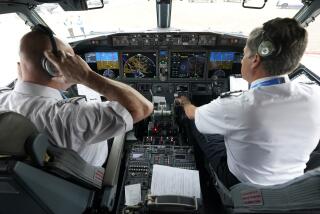Op-Ed: To understand the Kobe Bryant crash, it helps to know what it’s like to fly in iffy weather

The accident that took the lives of Kobe and Gianna Bryant and seven others must have seemed to most people an improbable, freakish event. To me, what was most surprising about it was its ordinariness.
I write a column analyzing airplane accidents for Flying Magazine. I have become a reluctant connoisseur of these macabre matters, sifting through dozens of accidents each month in search of ones from which I hope pilots can learn. The type I see most often is the very type of the Bryant accident: “Continued VFR into IMC” in pilot shorthand — continuing under visual flight rules into instrument meteorological conditions.
The scenario is a common one. In bad weather, a pilot with the proper qualifications would normally file an instrument flight plan, and could then fly through clouds by reference to instruments alone. But some pilots aren’t instrument qualified, and some who are may simply choose to stay below the clouds, as Ara Zobayan, the instrument-rated pilot of Bryant’s helicopter, did. In his case, it was reportedly because the charter operator did not have the FAA authorization required for instrument operations.
Zobayan certainly got a weather briefing before departing, so he knew the weather was iffy. But aviation weather is reported only at certain places. He would have known the ceiling and visibility at Burbank and Van Nuys — lousy, but flyable — and at the destination, Camarillo, which looked pretty good, with unlimited visibility and a broken ceiling at 1,800 feet. But he could not know the weather at Calabasas, or along the plateau between the San Fernando Valley and Camarillo. Those places don’t report aviation weather. The only way to know was to go have a look.
If things don’t look good, the pilot is expected to turn back. But “good” is never precisely defined. Pilots tend to move along, imperceptibly accustoming themselves to worsening conditions. Their impulse is always to go a little farther. They want to reach the destination. And they hope the weather is going to get better somewhere ahead.
Gradually, they may begin to accept downward visibility in place of forward visibility. Flying low, as helicopters often do, they can see the ground below even when they can barely make out what’s straight ahead. People watching from below see them pass overhead and vanish into cloud; but the pilots can still see the ground, and they think to themselves, “So far, so good.”
Then they start to lose sight of the ground, and they realize that this is not going to work.
What now?
In this case the National Transportation Safety Board’s investigation has only begun, but we have some information about what happened from a preliminary report the safety board issued. We know that the pilot reported to an air traffic controller that he was climbing to 4,000 feet. That would have put him safely above the clouds, whose tops were at 2,400.
The helicopter shot rapidly upward. And then something went wrong. Just before breaking out into the clear, it banked to the left and began to descend. It hit a hillside while dropping at 4,000 feet per minute. That is not a descent rate that would occur in normal flight; the helicopter was clearly out of control.
Various explanations — all, at this point, hypothetical — come to mind. Some sort of mechanical or instrument failure is possible, but it’s extremely improbable that it would happen to occur at the very moment that the helicopter pulled up into the clouds. Or Zobayan could have suffered some sort of incapacitating medical event like a stroke or aneurism.
But the most usual explanation — the one I have encountered again and again in other accidents of this kind — is that the pilot, deprived of visual cues in the clouds, experienced spatial disorientation, or vertigo. Vertigo is an extremely compelling, but false, sense of the body’s position. Most instrument pilots have experienced it at one time or another, often in the form of “the leans” — a sensation of being tilted rather than upright. It can be triggered by something as simple as a rapid head movement. It can be mild or dizzyingly violent.
Pilots who experience vertigo may first try to “correct” by banking the aircraft to restore their own sense of the vertical; but this puts the aircraft into a turn. They next feel bafflement: Why are the instrument indications wrong? Why do they say the aircraft is turning and descending? Then they realize what is happening and force themselves to ignore their physical sensations and obey the instruments.
All this takes time. At high altitude it’s not a serious problem, but near the ground, time is the enemy. If spatial disorientation was the culprit, for Kobe and Gianna and the others the clock ran out.
Peter Garrison writes the Aftermath column for Flying Magazine.
More to Read
A cure for the common opinion
Get thought-provoking perspectives with our weekly newsletter.
You may occasionally receive promotional content from the Los Angeles Times.










